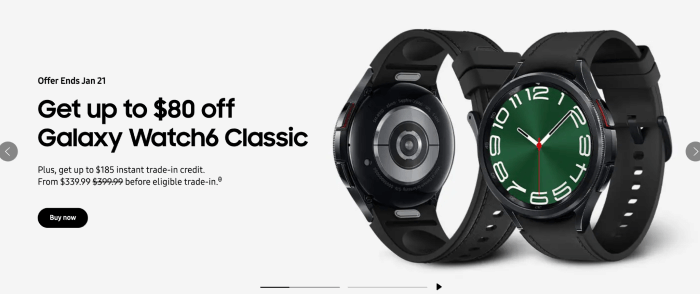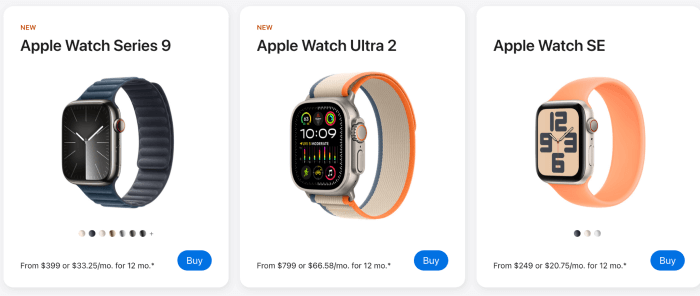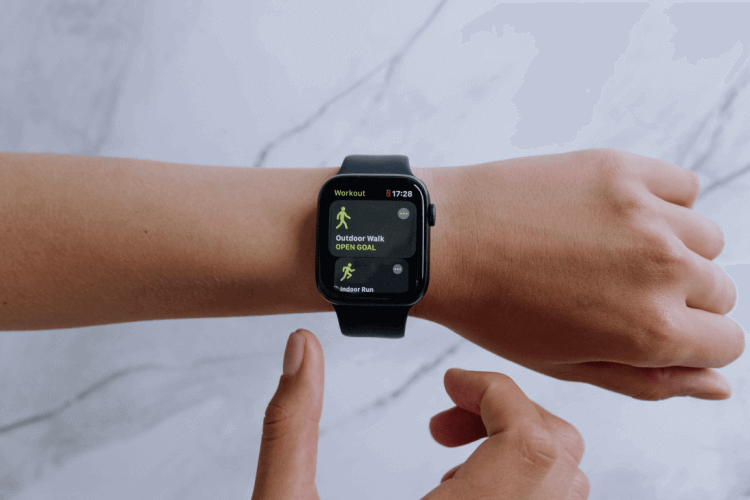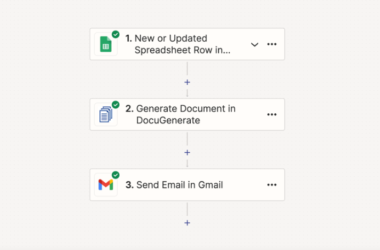Table of Contents Show
Explore the face-off between ‘Galaxy Watch vs Apple Watch’, unraveling their aesthetics, features, and functionality. Discover the best match for your lifestyle and productivity needs.
When it comes to smartwatches, the battle between Galaxy Watch and Apple Watch is fierce. Both offer a range of features and functionalities, making it a tough decision for managers and entrepreneurs looking to boost their productivity.
Design and Display
When looking at aesthetics, the Galaxy Watch oozes classic charm with its circular screen and rotating bezel, while the Apple Watch sways towards modern minimalism with its rectangular shape and sleek lines. Personal tastes would sway this battle.
Both Galaxy Watch and Apple Watch merge style with high-quality displays: Super AMOLED for sharpness, and LTPO OLED Retina for vibrant, rich colors respectively.
Analyzing display quality, the Galaxy Watch dazzles with its bright and sharp Super AMOLED display. However, the Apple Watch counterattacks, thanks to its vibrant LTPO OLED Retina display, serving vivid and rich colors with crystal clear sharpness. Both give a high-quality viewing experience, respective to their brand ethos.
Galaxy Watch design and display

The Galaxy Watch stands as a testament to intricate design, blending modern technology with traditional watch aesthetics to create a sophisticated look. The robust display offers a crisp viewing experience, whether it’s put through casual or rigorous daily usage.
- Design resemblance resembling classic timepieces
- Rotating bezel for smooth navigation
- Super AMOLED display for enhanced visual clarity
- High durability with military-standard (MIL-STD) 810G rating
- Always-on display feature
- Diverse size options catering to different wrist sizes
Apple Watch design and display

When it comes to design, the Apple Watch shines with its minimalistic charm. A clean, sleek form factor combined with an elegant user interface, it stands as a benchmark of sophistication in wearable technology.
- Display Size: Apple Watch Series 7 offers a more spacious, always-on Retina display with a size range of 41mm and 45mm.
- Display Quality: The Apple Watch ensures crisp visibility with a refresh rate of 60Hz.
- Screen Type: It boasts an LTPO OLED display contributing to superior color reproduction and sharpness.
- Resolution: With a resolution of 396×484 pixels for the 45mm variant, clarity is a given.
- Touchscreen: Apple Watch has a responsive touch interface coupled with Force Touch technology for enhanced interactions.
Features
In the face-off of features, both Galaxy Watch and Apple Watch offer an impressive range. However, the differences are clear. Samsung’s Galaxy Watch leans towards a more comprehensive health and wellness focus, while Apple shines in a seamless extension of its iOS ecosystem.
When it comes to practicality, the Galaxy Watch stands out with a user-friendly interface and extended battery life. On the other hand, Apple Watch, with its unrivaled app ecosystem, provides a plethora of options for customization and functionality.
Fitness tracking capabilities
In the fitness battleground, both Galaxy Watch and Apple Watch bring their A-game with robust features. But the ultimate fitness champ? It’s a close call.
- Both watches offer multi-sport tracking, daily activity tracking, and swim-proof designs.
- The Galaxy Watch shines with its dedicated stress management feature and automatic workout detection.
- The Apple Watch, on the other hand, outdoes its competitor with the advanced ECG app and blood oxygen (SpO2) monitoring.
Smartphone compatibility
When it comes to smartphone compatibility, both the Galaxy Watch and Apple Watch excel in providing seamless connectivity but differ in their accessibility across various devices. The Galaxy Watch favors a more inclusive approach, integrating smoothly with both Android and iOS. The Apple Watch, however, strictly pairs with iOS devices, thus limiting its range.
- Galaxy Watch allows users the versatility of pairing with both Android and iOS devices.
- Apple Watch pairs solely with iOS devices, catering to a more streamlined user base.
Battery life
When analyzing the longevity of Galaxy Watch and Apple Watch, it becomes evident that Galaxy Watch outperforms with typical usage, lasting an impressive 4 to 5 days. In contrast, the Apple Watch usually needs daily charging, managing to extend up to 2 days under optimal settings.
- Galaxy Watch battery longevity: 4-5 days with typical usage
- Apple Watch battery longevity: 1-2 days under optimal settings
Apps and ecosystem
When it comes to exploring the app ecosystems of both Galaxy and Apple Watches, the latter takes a slight lead with its wide-ranging, quality applications. The Galaxy Watch, however, is not far behind, increasingly bolstering its app portfolio to offer a comparable experience.
Examining the app interfaces of both devices, the Apple Watch’s UI is often applauded for being more user-friendly. Yet, the Galaxy Watch impresses with its customizable UI, presenting a tailored, engaging user experience.
Health and Wellness
In promoting health and wellness, both Galaxy Watch and Apple Watch offer exceptional features. From comprehensive heart rate monitoring, and sleep tracking, to stress management aspects, both smart wearables amplify your health-tracking capabilities.
Between Galaxy Watch and Apple Watch, the determination of which contributes more to health and wellness boils down to specific user requirements and app ecosystem preference. Both smartwatches showcase potentially life-saving attributes, encouraging users to stay active, eat well, and live a healthier lifestyle.
1. Heart rate monitoring
In the accuracy face-off between Galaxy Watch and Apple Watch, both provide real-time heart rate monitoring. However, some users claim that the Apple Watch slightly edges out in accuracy.
The Galaxy Watch offers a comprehensive heart rate tracking feature that alerts users if the heart rate goes above or below custom set levels, a proactive feature for fitness and health.
Apple Watch’s heart rate monitor stands out with its adaptive algorithm, adjusting to abrupt changes in user activity and comprehensively tracking throughout the day.
In the pulse tracker showdown between these two, it’s challenging to declare a clear winner. Both watches offer robust heart rate monitoring features that contribute significantly to users’ health and wellness insights.
2. Sleep tracking
Comparing sleep trackers, the Galaxy Watch and Apple Watch excel with their precision. Both leverage advanced algorithms to analyze sleep quality, duration, and stages, offering insightful pointers to enhanced rest.
The Galaxy Watch, a star in wearable tech, tracks four stages of sleep, helping users grasp their sleep cycle. Apple’s smartwatch also holds its ground by tracking sleep parameters effectively, complete with bedtime routines.
These innovations aren’t merely high-tech luxuries, but key tools in enhancing your sleep. With offerings like automatic sleep tracking and user-friendly interfaces, better nights could be a simple wrist-swipe away.
3. Stress management features
When it comes to driving productivity, both Galaxy Watch and Apple Watch understand the role of wellness in any ambitious manager or entrepreneur’s life. Their stress management features provide real-time insights to keep your emotional well-being in check.
Galaxy Watch is known for its innovative stress algorithms, providing helpful alerts when it detects you’re getting anxious and suggesting activities to unwind effectively. On the other hand, the Apple Watch offers the Breathe App for guided relaxation, acting as a potent tool to combat stress and maintain focus.
The stress management features of Galaxy Watch and Apple Watch aren’t just gadgets; they are dedicated wellness partners. Their goal is to ensure the well-being of their users, amplifying productivity by helping them manage stress more efficiently.
User Interface
In the quest for user interface supremacy, both Galaxy Watch and Apple Watch have strived for simplicity and sophistication. The ease of use in both timepieces is praiseworthy, although some might argue there’s an experiential edge to one over the other.
A comprehensive review brings out the stark differences in their approaches. Galaxy Watch opts for a tactile rotating bezel for navigation, whereas Apple Watch banks on its digital crown and touch interface. Both engage in a remarkable duel of usability and performance.
1. Operating system
Harnessing Google’s finest, the Galaxy Watch operates on the robust Android-based Wear OS, dedicated to durability and multitasking. In contrast, the Apple Watch runs on the smooth and intuitive watchOS, majorly admired for its seamless iOS integration.
The power behind the efficient operations of the Galaxy Watch lies in Wear OS. This OS offers exceptional adaptability with a multitude of Android devices, while Apple Watch utilizes watchOS that ensures a coherent user experience with an ecosystem of Apple devices.
Through wearOS, the Galaxy Watch manifests a diverse world of Android apps, giving users flexibility and customization. WatchOS on Apple Watch, though limited to Apple’s ecosystem, offers a well-integrated and streamlined interface, enhancing productivity and user interaction.
2. Navigation and controls
Navigating both the Galaxy Watch and Apple Watch comes with their unique sets of commands. Galaxy Watch banks on its traditional rotating bezel for navigation, while Apple Watch employs its iconic Digital Crown and touch screen for a seamless experience.
Inspecting closer, the Galaxy Watch’s navigation bets on tradition, balancing physical controls with innovative tech. Apple Watch takes full advantage of its touch-sensitive display, complementing the Digital Crown for precision commands.
Connectivity
The LTE functionality in both Apple Watch and Galaxy Watch keeps you tethered to your digital world, however, the superior clarity and frequency bands of Galaxy Watch’s LTE garners it an edge in connectivity.
Though both Galaxy and Apple Watches offer Bluetooth and Wi-Fi connectivity, the seamless integration of Apple’s ecosystem and its top-tier, dual-band Wi-Fi capabilities offer a slight advantage in the quest of wireless supremacy.
1. LTE and cellular capabilities
The cellular connectivity showdown puts Galaxy Watch and Apple Watch neck-to-neck as both offer robust LTE support, ensuring you stay connected even without your smartphone. It’s the modern watch’s answer to fostering seamless communication.
In terms of LTE capabilities, Galaxy Watch and Apple Watch both offer independent cellular communication. Therefore, answer calls, send texts, and stream music with either of these smartwatches, giving you full freedom and no excuse not to stay connected.
2. Bluetooth and Wi-Fi connectivity
When it comes to Bluetooth connectivity, the face-off is heated. Both, the Galaxy Watch and Apple Watch have steadfast Bluetooth connections. They pair swiftly and smoothly with your smartphone, ensuring you’re always in sync with your digital world.
Interestingly, Galaxy Watch offers Bluetooth 5.0, thus providing a considerable range and efficient power consumption. Apple Watch, although still on Bluetooth 4.2, complements this with its proprietary W2 wireless chip for reliable connectivity.
For fitness enthusiasts who love to disconnect yet stay updated, both watches allow Bluetooth pairing with headphones. So, tune into your favorite podcast or track while on the run!
Moving on to Wi-Fi connectivity, both Galaxy Watch and Apple Watch seamlessly auto-switch between Bluetooth and Wi-Fi. This functionality provides relief from worrying about data syncing while moving in and out of Wi-Fi zones.
Unquestionably, both smartwatches rule the realm of wireless connectivity. Whether it’s pushing notifications, syncing data, or keeping you entertained sans phone, Galaxy Watch and Apple Watch stand toe-to-toe in the Bluetooth and Wi-Fi connectivity face-off.
Style and Customization
Embracing the spirit of individuality, the Galaxy Watch and Apple Watch put a fantastic range of customization options at your fingertips. From a choice of different watch faces to the flexibility of alternating bands, each watch empowers its user to tailor their wearable fashion needs, fully acknowledging the eclectic aesthetic taste of today’s world.
Juxtaposing fashion and functionality, both Galaxy Watch and Apple Watch have been able to create a compelling mix of style and tech. Their wide array of designs, complemented by an immense arena of customizable watch faces and bands, offer a user experience that thrives on personalization, making them not just a smartwatch, but a brilliant statement of personal style.
1. Variety of watch faces and bands
Showcasing a myriad of watch faces and bands, both Samsung Galaxy Watch and Apple Watch are true masters of disguise. Each offers diverse choices for every taste, broadening users’ aesthetic horizons.
The Galaxy Watch boasts numerous options, from classic analog timepiece faces to quirky digital expressions. The choice of bands is equally varied, with sporty silicone, elegant leather, and even premium metal on offer.
Apple Watch, though similarly varied, leans more towards modern minimalism with its sleek and streamlined faces. It also offers a wide range of bands, from casual braided loops to sophisticated Milanese weaves.
Whether you’re channeling sporty chic or understated elegance, the wide array of watch faces and bands for both devices ensures your style is always reflected. It’s all about expressing personal style and mood on any given day.
Regardless of the watch you choose, Galaxy or Apple, the spectrum of aesthetic options ensures a satisfying experience. Adapt your watch to your lifestyle and not the other way around for enhanced productivity and flair.
Price and Value
When we break down the value proposition, the Galaxy Watch brings impressive durability and diverse features at a lower price point, compared to the Apple Watch. Yet, the latter’s seamless integration with the Apple ecosystem can justify its high price tag for some.
Assessing the price-to-features ratio, both are noteworthy investments. Galaxy Watch shines with its long-lasting battery and wide-ranging features while Apple Watch impresses with its high-end health tech and unbeatable OS performance.
1. Galaxy Watch pricing options

With value at its core, the pricing options for Galaxy Watch predominantly reflect its impressive combination of style, connectivity, health, and productivity features. This rightly positions the Galaxy Watch as a feature-packed wearable at a competitive price.
A comprehensive look at Galaxy Watch’s pricing structure indicates its stride towards economical pricing. Coupled with its slew of features, this smartwatch offers value for both tech enthusiasts and casual users alike.
In both its basic model and high-end variants, the Galaxy Watch ensures value delivery. Its price range not only represents a variation in on-board storage and LTE support but also echoes their commitment towards accessibility for varied client bases.
Even the costlier models of the Galaxy Watch offer reasonable pricing, especially when compared to the plethora of functions that come embedded within. From seamless smartphone compatibility to superior battery life, these aspects seem to justify the pricing criteria.
Galaxy Watch’s pricing structure is an attempt to cater to different budget classes, thus making it an attractive choice for those who want smart functionality without breaking the bank. The value offered surely marks its position strongly in the smartwatch market.
2. Apple Watch pricing options

The affordability of the Apple Watch often provokes debate. It’s undeniable that it tilts towards the higher price range in the market. However, when factoring in its advanced tech, unique features, and superior ecosystem, many argue the cost is justified.
Understanding the Apple Watch’s pricing outlay requires a deep dive into its offerings. Each model comes packed with cutting-edge capabilities, ranging from comprehensive health tracking to seamless connectivity, justifying its higher price tag.
It’s important to assess one’s own needs and budget. If you’re seeking an unparalleled user experience and robust features and can bear a higher cost, then the Apple Watch’s price becomes quite reasonable.
Conclusion
Whether you choose the Galaxy Watch or the Apple Watch, both smartwatches have their unique strengths and capabilities. Ultimately, the decision should be based on your personal preferences and needs as a manager or entrepreneur.
Whichever watch you choose, it’s clear that these devices can greatly enhance your productivity and help you get more done.
More articles:










